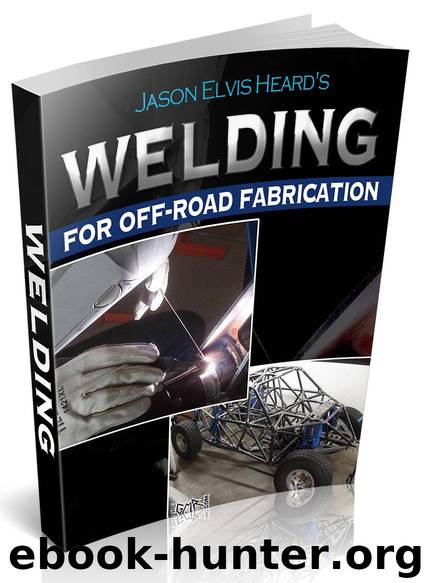Welding for Off-Road Fabrication by Jason Heard

Author:Jason Heard [Heard, Jason]
Language: eng
Format: epub
Published: 2013-12-18T06:00:00+00:00
My Preferred Wire, Gas, Electrode Selection for Different Applications
The wire and gas that you select will be key to yielding the best results for each specific application below. Although there are many available wires and gas combinations, these below will get you going in the right direction from the start. As for the amperage and wire speed, they will vary depending on the material thickness, welder, and wire thickness.
MIG welding plate work / chassis work Cold Rolled Steel and Chromoly Steel 0.083-0.375” Thick: This is the majority of what off-road welding will accumulate. These items included cold / hot rolled steel and Chromoly steel-plate work, such as arms, frame gusset, and mounts.
I prefer to use the Airgas Gold Mix of 75/25 with the majority (75%) argon and the remainder (25%) CO2. Even if you are not getting your gas mixes from Airgas, then you can simply ask for the Gold Mix for Steel welding. It is very common and relatively economical. The common flow rates for you to use will be 15-20 in no wind conditions and as much as 20-24 in windy conditions.
What you want to avoid is pure CO2 gas. It will be too hot for traditional off-road material thicknesses. Now for the matching wire, I prefer to use ER80S-D2 for just about all DOM, cold-rolled, hot-rolled, and Chromoly welding. The traditional ER70S-6 wire will work great as well, but I prefer to use the ER80S-D2 because it’s smoother, stronger, and works great even when heat treating comes into the equation. You can get it in spools for all the above welders.
For all chassis welding and suspension-component welding where you have a max thickness of 3/16” (0.188), I prefer to utilize wire thickness of 0.030”. And for thicker components such as rear-end housings with tube thicknesses of 0.25” or greater, I prefer to step up the wire thickness to 0.035” in diameter. If you are only going to get one wire for all your off-road welding needs, the 0.030 ER80S-D2 will be the best all around for weld quality and penetration.
TIG welding plate work / chassis work Cold Rolled Steel and Chromoly Steel: For those who are going to be TIG welding, both traditional steel(hot-rolled, cold-rolled, and DOM) and Chromoly, stick to ER80S-D2 welding rod. The ER70s rods will work as well, but again I just have a preference, based on my experience. It melts smoother, provides great strength, and the look is phenomenal.
To back that up, you will want to tell your gas supplier to get you “TIG welding Steel 100% Argon” gas for your TIG machine. As for the thickness on the rod, I prefer to use 1/16” for just about everything off-road. For the tungsten size I stick to the Red cap 3/32” RED tipped pieces. In the preparation section I review the methods I use to sharpen the tungsten.
As for the gas flow of the argon, I prefer to stay in the 17-22 range. Just be sure to be in a low to minimum
Download
This site does not store any files on its server. We only index and link to content provided by other sites. Please contact the content providers to delete copyright contents if any and email us, we'll remove relevant links or contents immediately.
| Buyers' Guides | Classic Cars |
| Customize | Driver's Education |
| Electric & Hybrid | Foreign |
| History | Industry |
| Insurance | Luxury |
| Motorcycles | Pictorial |
| Racing | Repair & Maintenance |
| Trucks & Vans |
Machine Learning at Scale with H2O by Gregory Keys | David Whiting(4172)
Never by Ken Follett(3787)
Urban Outlaw by Magnus Walker(3338)
OPNsense Beginner to Professional by Julio Cesar Bueno de Camargo(3249)
Sapiens and Homo Deus by Yuval Noah Harari(2986)
Will by Will Smith(2790)
A Short History of Nearly Everything by Bryson Bill(2627)
Hooked: A Dark, Contemporary Romance (Never After Series) by Emily McIntire(2496)
Rationality by Steven Pinker(2290)
Borders by unknow(2227)
Holy Bible (NIV) by Zondervan(2086)
The Becoming by Nora Roberts(2085)
The One Percenter Encyclopedia by Bill Hayes(1787)
HBR's 10 Must Reads 2022 by Harvard Business Review(1776)
Freedom by Sonny Barger(1770)
A Short History of War by Jeremy Black(1758)
Five Ways to Fall by K.A. Tucker(1697)
Go Tell the Bees That I Am Gone by Diana Gabaldon(1685)
Girls Auto Clinic Glove Box Guide by Patrice Banks(1682)
